Air Barriers and Insulation
Fluid Applied Air and Water Barriers:
The Science Behind the Product
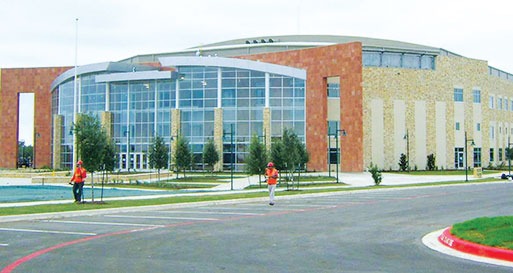 |
| Figure 1. Shown is a typical commercial project utilizing a fluid applied air and water barrier in conjunction with a natural stone veneer finish. Photo courtesy of LATICRETE International Inc. |
Air and water barriers serve an important role in the functionality of high-performance building veneers. Many factors go into the engineering of a building’s exterior envelope, not the least of these is the design, selection, construction and the installation of the air and water barrier and any finishes that are applied over the membrane.
Air barrier materials are defined by the air permeance. To qualify as an air barrier product, the air permeance must be equal to or less than 0.02L/(s•m2) @ 75Pa (0.004 cfm/ft2 @ 1.57 psf) when tested in accordance with ASTM E2178.
Air permeance is the amount of air that migrates through an air and water barrier material. For more information on air barriers, visit the Air Barrier Association of America (ABAA) at www.airbarrier.org.
In addition, the ability for an air barrier to manage moisture migration through a buildings veneer is just as critical. Typically, water barriers are vapor permeable and are designed to meet a range of permeance levels. The criterion used to qualify these membrane characteristics may require specific project testing.
Several composition types of air and water barriers are available in the market (e.g. liquid applied, sheet types, etc.). Fluid applied air and water barriers have specific advantages, in that they can be applied easily using high-production techniques (e.g. airless sprayer, power rollers, etc.) and provide a seamless installation. Fluid applied products are more prone to seal up difficult-to-reach sections of a building envelope and will seal up tighter around penetrations.
In addition, fluid applied systems are fully adhered to a substrate versus sheet types that rely on either limited adhesion or on mechanical attachment, which can defeat the continuity of the product. These products are scientifically engineered to achieve performance characteristics that can protect a building’s envelope and improve its efficiency.
We will consider four factors that can help a specifier select an appropriate air and water barrier product for the project:
- Test methods/standards
- Building codes
- Building envelope construct and substrate type
- Building envelope finishes and method of attachment/adhesion
The selection process begins with an understanding of which relevant test methods and specifications are required for the specific project/application. In addition, local building codes also play an important role in identifying which air and water barrier type is ultimately selected, and which performance specifications are required for a given project/application.
The construct and substrate type of the building envelope will factor into what performance values are ultimately required and will help to narrow down which product can be specified. The method of attaching/adhering the finish type also bears on which product can be used. Simply put, if a veneer type is scheduled to be directly adhered to the air and water barrier, then that product must have the ability to accept an adhesive for this purpose. Let’s consider these four factors in more depth.
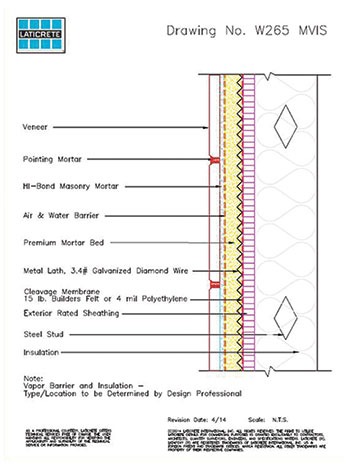 |
| Figure 2. Shown is a typical wall construct cross section that includes a fluid applied air and water barrier. Detail courtesy of LATICRETE International Inc. |
Test methods
Generally, the reported test values are the result of testing an actual assembly in its entirety. The following test methods/standards generally apply to fluid applied air and water barriers (including but not limited to):
- ASTM E2178 – Standard Test Method for Air Permeance of Building Materials
- ASTM E2357 – Standard Test Method for Determining Air Leakage of Air Barrier Assemblies
- ASTM E96 – Standard Test Method for Water Vapor Transmission of Materials (specify which test method – e.g. Procedure A desiccant method, Procedure B water method, Procedure E high humidity method)
- AC212 – Water-Resistive Coatings used as Water-Resistive Barriers over Exterior Sheathing
- ASTM C297 – Standard Test Method for Flatwise Tensile Strength of Sandwich Constructions (used to test adhesion to penetrations of various compositions through membrane)
- ASTM D2247 – Standard Practice for Testing Water Resistance of Coatings in 100% Relative Humidity
- ASTM D4541 – Standard Test Method for Pull-Off Strength of Coatings Using Portable Adhesion Testers
- ASTM E331 – Standard Test Method for Water Penetration of Exterior Windows, Skylights, Doors, and Curtain Walls by Uniform Static Air Pressure Difference
- ASTM E 1233 – Standard Test Method for Structural Performance of Exterior Windows, Doors, Skylights, and Curtain Walls by Cyclic Air Pressure Differential
- ASTM E 72 – Standard Test Methods of Conducting Strength Tests of Panels for Building Construction (used to test shear strength as it relates to racking)
- American Association of Textile Chemists and Colorists (AATCC) 127 – Water Resistance – Hydrostatic Pressure Test
- ASHRAE 90.1-2010 – Section 5.4.3 Air Leakage
- ASHRAE 189.1-11 – 7.4.2 Building Envelope & Normative Appendix B – Prescriptive Continuous Air Barrier
The values achieved by a specific product in any of the above categories are important factors when tailoring the product for a project. For example, if the engineering study for a project requires that the air and water barrier have a rating of 1.0 perms or less per ASTM E-96 (procedure B as called for in ICC ES AC212); that requirement serves as a filter for products that are being considered for the project.
The engineering study should determine which characteristics carry the most weight for the intended design.
Building codes
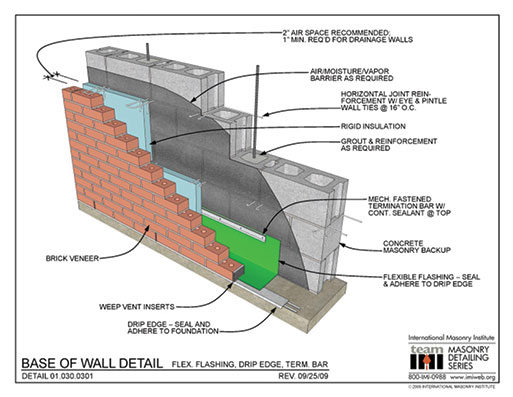 |
|
| Figure 3. Shown is an example of a cavity wall construct with a full brick veneer finish installed over a CMU back-up wall. Notice the air and water assembly applied over the CMU back-up wall. Detail courtesy of IMI. | |
Compliance to codes and regulatory mandates requires the use of air and water barriers to improve energy efficiency. For example, the U.S. Department of Energy requires them on federally funded building projects. Certain states have mandated that air and water barriers be used on new building constructs as part of energy conservation codes and building codes. The U.S. Department of Energy has instituted a program with a goal to reduce building energy consumption by 50 percent by the year 2020. Simply put, tighter buildings use less energy.
It’s important to note that the entire building envelope assembly be evaluated in its entirety as requirements for additional vapor barriers and thermal protection also may be required.
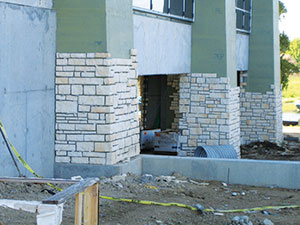 |
|
| Figure 4. Shown is an example of manufactured adhered veneer installed over a fluid applied air and water assembly product that can accept a direct bond installation of veneer finishes. Photo courtesy of LATICRETE International Inc. | |
Note that commercial building constructs have different requirements when compared to residential constructs:
- Per the 2012 – ICC commercial constructs require the following vapor permeability for projects – vapor permeance rating of 10 perms (5.7 x 10-10 kg/Pa???s???m2) or greater, when tested in accordance with the desiccant method using Procedure A of ASTM E96.
- Per the 2012 – IRC commercial constructs require the following vapor permeability for projects – vapor permeance rating of 5 perms (2.9 x 10-10 kg/Pa???s???m2) or greater, when tested in accordance with the desiccant method using Procedure A of ASTM E96.
The following is a list of building codes that includes references and requirements for air and water barriers assemblies and products:
- IBC [International Building Code] – 2012 – Chapter 14 – Exterior Walls
- IRC [International Residential Building Code] – 2012 – Chapter 7 – Exterior Walls
- IECC [International Energy Conservation Code] – 2012 – C402.4 & R 402.4 – Air Leakage
- IgCC [International Green Construction Code] – 2012 – Section 605 – Building Envelope Systems
Substrate/construct type
The third and fourth factors for air and water barrier product selection go hand in hand. Typical backup wall constructs consist of concrete, concrete masonry units, wood or steel framed assemblies with fastened lath and plaster systems, wood or steel framed assemblies with exterior rated sheathing or properly designed cement backer board substrates.
Design and placement location of air and water barriers can vary depending on the construct type, climate and type of building envelope (see Figure 2).
Typically, fluid applied air and water barriers are placed on the underlying substrate or sheathing. In some cases, the location of the membrane may of necessity be placed behind the building’s exterior envelope. In addition, specify a product that includes a complete line of complementary flashing tapes and sealants that will create a complete building envelope system (see Figure 5).
These are design considerations that must be evaluated for specific projects.
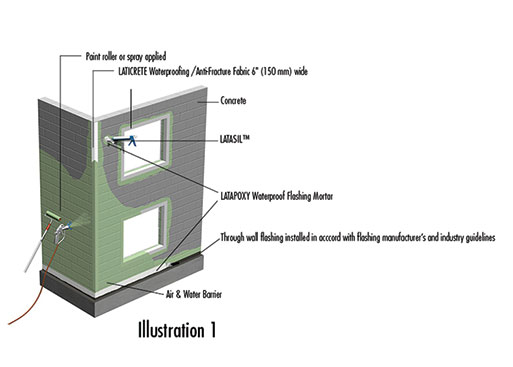 |
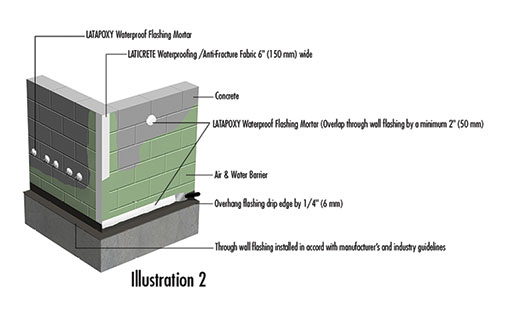 |
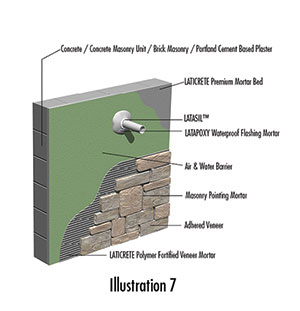 |
| Figure 5. Shown are detailing examples of a direct adhered veneer applied over fluid air and water assembly product that can accept a direct bond installation of veneer finishes (illustration 7). Notice the assortment of tapes, sealants and other complementary accessories that help create a complete envelope system (illustrations 1 and 2). Details courtesy of LATICRETE International Inc. |
Veneer type and attachment methods
The fourth factor can be viewed in three main categories and can bear on the selection of a product type and placement location. Critical application modeling and detailing of the air and water barrier installation are important features and benefits of the ultimate products selected and utilized. The veneer type and attachment categories that we will consider are as follows:
Cavity wall veneers
This construct type is commonly used with full brick, mechanically anchored stone masonry veneers, mechanically anchored rain screen assemblies (see Figure 3). Typically, a cavity wall construct of this type will maintain a minimum of one inch (25 mm) to 1.5 inch (38 mm) cavity between the rear of the brick veneer and the backup wall construct (e.g. cmu/concrete/framed construct with exterior rated sheathing). Since brick tabs/tie backs will penetrate the air and water barrier, the product needs to be tested for re-sealability per ASTM D1970 – Fastener Sealability.
Further prescriptive requirements of exterior anchored veneers fall under the auspices of Chapter 6 of the Building Code Requirements for Masonry Structures TMS 402/ACI 530/ASCE 5.
Direct adhered veneers
This construct type is commonly used with thin brick, manufactured masonry, ceramic tile, porcelain tile and natural stone tile veneers. When these finish types are specified, the air and water barrier product must be of the type that can accept a direct bond installation typically accomplished by using a high-performance latex fortified thin bed adhesive mortar (see Figures 4 and 5). Not all air and water barrier products are designed for this purpose.
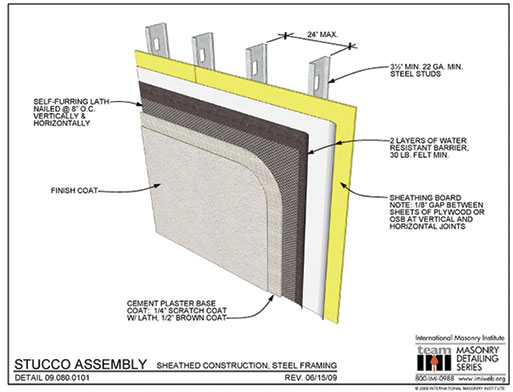 |
| Figure 6. Shown is an example of framed wall construct with a cement plaster finish. Notice the wire lath/fasteners that penetrate air and water barrier assembly. Detail courtesy of IMI. |
Further prescriptive requirements of exterior adhered veneer fall under the auspices of Chapter 6 of the Building Code Requirements for Masonry Structures TMS 402/ACI 530/ASCE 5; namely section 6.3 – Adhered Veneer.
Cement backer board applications installed over steel framing in accord with Tile Council of North America Method W-244 (E) is a commonly specified installation system for adhered veneers (see Figure 5) that incorporate an air and water barrier membrane.
Veneers that require penetration through the air and water barrier
This construct type is commonly used with lath and plaster finishes. Since wire lath and its fasteners will penetrate the air and water barrier, the product selected for this veneer type must also be tested for re-sealability per ASTM D1970 – Fastener Sealability (see Figure 6).
In some cases, mechanical anchoring of veneers applies to the category of finishes. In these cases, follow the prescriptive requirements of exterior anchored veneers, which fall under the auspices of Chapter 6 of the Building Code Requirements for Masonry Structures TMS 402/ACI 530/ASCE 5.
Summary
Property owners continue to demand performance and energy efficiency from their properties.?? As building design and construction techniques continue to evolve, air and water barriers will continue to play an important role in the functionality of high-performance building veneers.
Therefore, the selection of an appropriate air and water barrier must be made by considering which factors and performance criteria are the most appropriate and relevant to that specific project design. Considering the four factors in this discussion can assist property owners, their design teams and specifiers to make the proper air and water barrier selection.
Arthur Mintie is director, technical services for LATICRETE International Inc. For more information, visit www.laticrete.com.